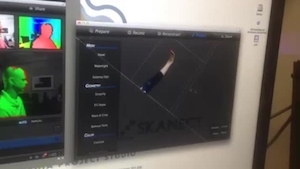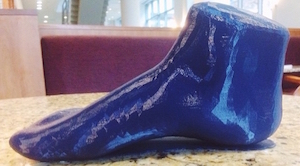Rethinking Student Innovations
In the nearly two years that Duke University's Innovation Co-Lab has been operating as a forum for allowing students to reinvent IT on campus, it has allowed itself to be re-invented too.
- By Dian Schaffhauser
- 11/13/14
In an October 2013 article, Campus Technology profiled Co-Lab, which mixed hackathons, weekly studio nights, development challenges and start-up services to help infuse Duke University's Office of Information Technology (OIT) with student ideas and innovation. In the intervening year, the workings of Co-Lab have taken on a different flavor. However, the original mission remains the same: to allow students to play a role in the technology they interact with on a day-to-day basis. "We've tweaked how to get to that end," said IT Innovation Program Manager Michael Faber.
Recently, Faber and Evan Levine, director for Academic & Media Technologies within OIT, shared what they've learned about Co-Lab as it has matured from "proof of concept" to campus service.
Fewer Challenges, More Grants
The Co-Lab is moving toward a smaller number of larger development challenges because it wasn't getting the kind of participation it wanted. "Busy Duke students," as Levine called them, couldn't commit the kind of time and risk the challenges required to create projects "of the quality and scope we were looking for."
Likewise, he noted, with the challenges, Co-Lab found itself in charge of defining what the competition would challenge students to do — whether that was to create apps for its campus mobile app, develop icons for an international iconography initiative or design and produce 3D objects. The outcome imposed a "severe" limitation on "the population of students [who] would be able to participate in our challenge right off the bat. We would pick a theme, but everybody who had ideas outside that theme had nowhere to go with it."
Although Co-Lab has reduced the number of challenges, it hasn't abandoned them entirely. "We're trying to focus on a few per year in the bigger areas that are going to be successes," Levine said." For example, because a 3D printing challenge last year turned out to be a major draw across multiple disciplines, that one is being repeated this month.
The concept of continual challenges is succeeded by a grant program. "Any idea [a student has] suddenly becomes valid," he noted. "And through that we've had some really interesting grant proposals that would not have come up necessarily through the challenge format."
The underlying premise is that the projects that receive support will either benefit the Duke community or have potential to become a great success story for the program based on its "cool" factor, explained Faber.
Grants Make Students More Self-Sufficient
In the process of applying for grants, students come up with their own ideas for projects, create their own timeline, compile a list of required resources and build a budget. "They have to answer a lot of questions before they would be awarded a grant," said Levine. The hurdle is intentional, forcing students to examine just how feasible their project is.
If the proposal is accepted, Co-Lab provides the funding up front, along with project management support. That last component is now an important aspect of Co-Lab's work. Students are "really skilled, and they know how to do the technical part, and they know how to identify a need that is worth solving," Faber noted. But he meets weekly or every other week with participants to make sure "they're on task, so there's a continued expectation of progress on the project."
Co-Lab also helps students get a handle on project scope. "Part of the consultation is focusing them down to a consumable size of project that they can get done," he said.
Budgeting has been an eye-opener for Co-Lab, which has encouraged the students to tack on a stipend for the time they'll spend working on their projects. They hardly ever do. "They're asking for less than I would have anticipated," Levine noted. "The opportunity is there to ask for compensation for time. A lot of them have bypassed that and just asked for money for equipment to do the project. They're definitely not abusing that process."
As a result, not only will grant funding stretch further, but it proves the students are internally motivated to undertake their projects. "They really believe in the projects that they're doing," he observed.
Grants Open Up Participation
Although Co-Lab had initial concerns that the new grant program would draw only "a bunch of guys that are computer science majors that are doing programming," that hasn't turned out to be true. Take SmartStrides, a project that falls into the "cool" category. This one was undertaken by two female students, Ivonna Dumanyan, who is pursuing a master's degree in engineering, and Brianca King, an undergraduate in electrical and computer engineering. As an athlete Dumanyan came up with the idea of developing a sensor that could go in or on a running shoe to help a runner identify potential cases of pronation or supination as the foot hits the ground.


Photos courtesy of Ivonna Dumanyan, Duke University
|
The initial idea was "very ambitious," said Faber. It involved development of the sensor as well as an app to do data interpretation; shoe design and prototyping; and integration of the sensor, shoe and app. Co-Lab persuaded Dumanyan to refocus specifically on one aspect: the sensor.
"She's learned a ton," said Faber. "She's not a hardware engineer, but she's taken it up as a hobby to learn those skills and apply it to her interest in fitness. Now she's working on this one little sensor that will detect one thing about your run and be able to give you feedback on how to correct that so you can run more safely."
Eventually, the team will work with the Duke athletics department to test the sensor and "get some real data" from users who may benefit from the technology and improve their performance while reducing injuries.
The total grant size: in the several hundreds of dollars. "It has not been expensive," added Levine.
Divide and Conquer
The 3D E-Print project is definitely part of the service-to-the-Duke-community camp. A team of electrical engineering and computer science students are developing apps that allow students and faculty to send print files to 3D printers in the same way they currently handle regular print jobs.
However, in this case the project is part of a larger initiative by OIT to address the scaling of 3D printing on campus. A student team is tackling the development and exploration aspects of that challenge, which will allow users to upload their 3D files to a server, check files for printability and send files to specific printers, confirming that printers are available, the print bed is level, and the system is "good to go." Meanwhile, OIT is focusing on operational aspects such as physical locations for printers, printer maintenance, filament procurement and instructional assistance.
The student team is meeting with members of OIT to share what they've learned in their experimentation and to make sure the solution is cohesive, Faber said. "It's kind of a back and forth thing. We're trying to arrive at the solution together. Knowing that it's something that eventually we're going to have to support, we're going to have insert ourselves more into the process."
Find the Boundaries
Over the last year, Co-Lab has strengthened its partnership with the Innovation and Entrepreneurship program to better fit into this larger ecosystem. Both organizations have worked on improving communications and holding joint events. "There's just a smoother flow between the two groups," Faber said. "A lot of it has been understanding the boundaries of things and where Co-Lab support might end and where it will be picked up by other groups on campus within the Innovation and Entrepreneurship umbrella."
Another call for boundaries surfaced when OIT attempted to integrate a student-developed dining app created during a mobile app challenge that added features beyond what was provided in an existing program. "At first glance, the thought was, oh, this is fantastic. Let's just swap it out for the old one we had built," recalled Levine. "It turned out not to be quite that easy. It wasn't done in a way that it could be popped into place with the other Duke apps." The new app ended up needing tweaking by the student developers and a "fair amount of rewriting" by the professional development group that had created the original DukeMobile campus software. "It was a great idea. It was absolutely better than starting from scratch. It was not easy. It did not result in no work for the operational teams within central IT."
In the future, Levine said, when the university invites students to contribute to the mobile application, OIT will create templates for students to use as a framework to hold their programming to ensure that what they develop will pop into the existing app suite more easily. Also, potential grant projects will be reviewed for how well they would fit into what's already existing and "how it will be operationalized."
Never Stop Innovating
Co-Lab isn't seeing much traction from instructors integrating its services into the coursework assigned to students, and that's an area Levine said he hopes to expand in the next couple of years.
The exception is a recently funded project that does have faculty support. A team of two students is developing a virtual reality application that allows users wearing an Oculus Rift headset to explore objects of "vastly differing sizes" in the universe. The students are in independent studies with two faculty advisors who helping with the subject matter while Co-Lab helps with overall project management.
That type of connection may just end up being the sweet spot for Co-Lab. Its free, helpful services show students how to mix their academics with their personal interests.
As Levine said, with the advent of MOOCs and success of non-traditional and online education, "things like this provide that important experiential piece. We want the Co-Lab to be a reason you'd come to an institution like Duke."